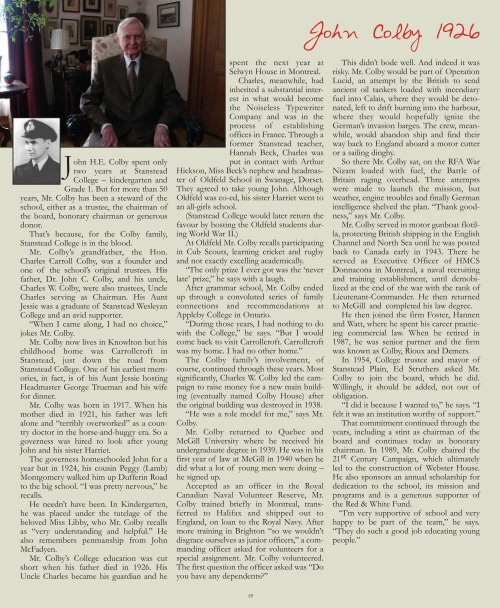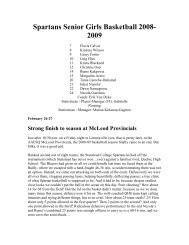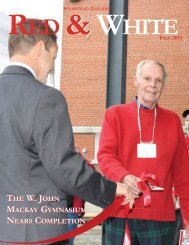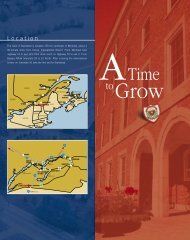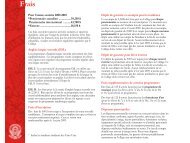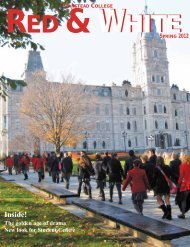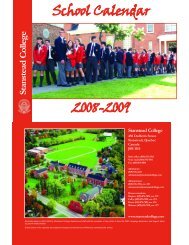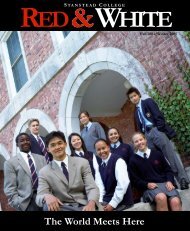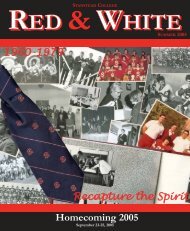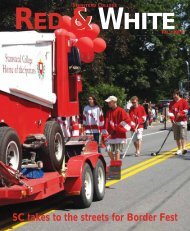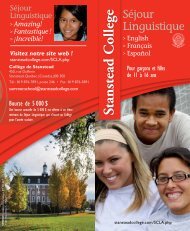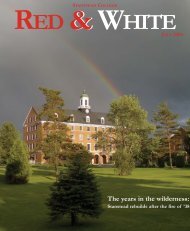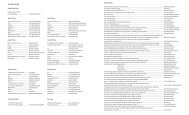THE HEAVY LIFTERS - Stanstead College
THE HEAVY LIFTERS - Stanstead College
THE HEAVY LIFTERS - Stanstead College
Create successful ePaper yourself
Turn your PDF publications into a flip-book with our unique Google optimized e-Paper software.
J<br />
ohn H.E. Colby spent only<br />
two years at <strong>Stanstead</strong><br />
<strong>College</strong> – kindergarten and<br />
Grade 1. But for more than 50<br />
years, Mr. Colby has been a steward of the<br />
school, either as a trustee, the chairman of<br />
the board, honorary chairman or generous<br />
donor.<br />
That’s because, for the Colby family,<br />
<strong>Stanstead</strong> <strong>College</strong> is in the blood.<br />
Mr. Colby’s grandfather, the Hon.<br />
Charles Carroll Colby, was a founder and<br />
one of the school’s original trustees. His<br />
father, Dr. John C. Colby, and his uncle,<br />
Charles W. Colby, were also trustees, Uncle<br />
Charles serving as Chairman. His Aunt<br />
Jessie was a graduate of <strong>Stanstead</strong> Wesleyan<br />
<strong>College</strong> and an avid supporter.<br />
“When I came along, I had no choice,”<br />
jokes Mr. Colby.<br />
Mr. Colby now lives in Knowlton but his<br />
childhood home was Carrollcroft in<br />
<strong>Stanstead</strong>, just down the road from<br />
<strong>Stanstead</strong> <strong>College</strong>. One of his earliest memories,<br />
in fact, is of his Aunt Jessie hosting<br />
Headmaster George Trueman and his wife<br />
for dinner.<br />
Mr. Colby was born in 1917. When his<br />
mother died in 1921, his father was left<br />
alone and “terribly overworked” as a country<br />
doctor in the horse-and-buggy era. So a<br />
governess was hired to look after young<br />
John and his sister Harriet.<br />
The governess homeschooled John for a<br />
year but in 1924, his cousin Peggy (Lamb)<br />
Montgomery walked him up Dufferin Road<br />
to the big school. “I was pretty nervous,” he<br />
recalls.<br />
He needn’t have been. In Kindergarten,<br />
he was placed under the tutelage of the<br />
beloved Miss Libby, who Mr. Colby recalls<br />
as “very understanding and helpful.” He<br />
also remembers penmanship from John<br />
McFadyen.<br />
Mr. Colby’s <strong>College</strong> education was cut<br />
short when his father died in 1926. His<br />
Uncle Charles became his guardian and he<br />
spent the next year at<br />
Selwyn House in Montreal.<br />
Charles, meanwhile, had<br />
inherited a substantial interest<br />
in what would become<br />
the Noiseless Typewriter<br />
Company and was in the<br />
process of establishing<br />
offices in France. Through a<br />
former <strong>Stanstead</strong> teacher,<br />
Hannah Beck, Charles was<br />
put in contact with Arthur<br />
Hickson, Miss Beck’s nephew and headmaster<br />
of Oldfeld School in Swanage, Dorset.<br />
They agreed to take young John. Although<br />
Oldfeld was co-ed, his sister Harriet went to<br />
an all-girls school.<br />
(<strong>Stanstead</strong> <strong>College</strong> would later return the<br />
favour by hosting the Oldfeld students during<br />
World War II.)<br />
At Oldfeld Mr. Colby recalls participating<br />
in Cub Scouts, learning cricket and rugby<br />
and not exactly excelling academically.<br />
“The only prize I ever got was the ‘never<br />
late’ prize,” he says with a laugh.<br />
After grammar school, Mr. Colby ended<br />
up through a convoluted series of family<br />
connections and recommendations at<br />
Appleby <strong>College</strong> in Ontario.<br />
“During those years, I had nothing to do<br />
with the <strong>College</strong>,” he says. “But I would<br />
come back to visit Carrollcroft. Carrollcroft<br />
was my home. I had no other home.”<br />
The Colby family’s involvement, of<br />
course, continued through these years. Most<br />
significantly, Charles W. Colby led the campaign<br />
to raise money for a new main building<br />
(eventually named Colby House) after<br />
the original building was destroyed in 1938.<br />
“He was a role model for me,” says Mr.<br />
Colby.<br />
Mr. Colby returned to Quebec and<br />
McGill University where he received his<br />
undergraduate degree in 1939. He was in his<br />
first year of law at McGill in 1940 when he<br />
did what a lot of young men were doing –<br />
he signed up.<br />
Accepted as an officer in the Royal<br />
Canadian Naval Volunteer Reserve, Mr.<br />
Colby trained briefly in Montreal, transferred<br />
to Halifax and shipped out to<br />
England, on loan to the Royal Navy. After<br />
more training in Brighton “so we wouldn’t<br />
disgrace ourselves as junior officers,” a commanding<br />
officer asked for volunteers for a<br />
special assignment. Mr. Colby volunteered.<br />
The first question the officer asked was “Do<br />
you have any dependents?”<br />
29<br />
John Colby 1926<br />
This didn’t bode well. And indeed it was<br />
risky. Mr. Colby would be part of Operation<br />
Lucid, an attempt by the British to send<br />
ancient oil tankers loaded with incendiary<br />
fuel into Calais, where they would be detonated,<br />
left to drift burning into the harbour,<br />
where they would hopefully ignite the<br />
German’s invasion barges. The crew, meanwhile,<br />
would abandon ship and find their<br />
way back to England aboard a motor cutter<br />
or a sailing dinghy.<br />
So there Mr. Colby sat, on the RFA War<br />
Nizam loaded with fuel, the Battle of<br />
Britain raging overhead. Three attempts<br />
were made to launch the mission, but<br />
weather, engine troubles and finally German<br />
intelligence shelved the plan. “Thank goodness,”<br />
says Mr. Colby.<br />
Mr. Colby served in motor gunboat flotilla,<br />
protecting British shipping in the English<br />
Channel and North Sea until he was posted<br />
back to Canada early in 1943. There he<br />
served as Executive Officer of HMCS<br />
Donnacona in Montreal, a naval recruiting<br />
and training establishment, until demobilized<br />
at the end of the war with the rank of<br />
Lieutenant-Commander. He then returned<br />
to McGill and completed his law degree.<br />
He then joined the firm Foster, Hannen<br />
and Watt, where he spent his career practicing<br />
commercial law. When he retired in<br />
1987, he was senior partner and the firm<br />
was known as Colby, Rioux and Demers.<br />
In 1954, <strong>College</strong> trustee and mayor of<br />
<strong>Stanstead</strong> Plain, Ed Struthers asked Mr.<br />
Colby to join the board, which he did.<br />
Willingly, it should be added, not out of<br />
obligation.<br />
“I did it because I wanted to,” he says. “I<br />
felt it was an institution worthy of support.”<br />
That commitment continued through the<br />
years, including a stint as chairman of the<br />
board and continues today as honorary<br />
chairman. In 1989, Mr. Colby chaired the<br />
21 st Century Campaign, which ultimately<br />
led to the construction of Webster House.<br />
He also sponsors an annual scholarship for<br />
dedication to the school, its mission and<br />
programs and is a generous supporter of<br />
the Red & White Fund.<br />
“I’m very supportive of school and very<br />
happy to be part of the team,” he says.<br />
“They do such a good job educating young<br />
people.”


